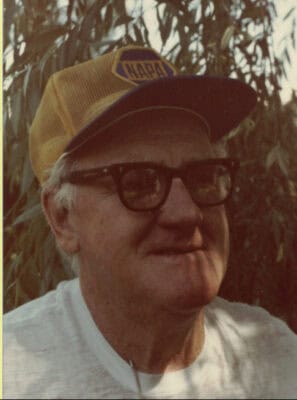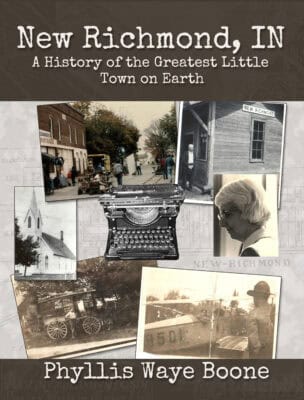This is the text of a talk I gave several years ago at the Montgomery County (Indiana) Genealogy Society. My love of writing comes in a direct line from my maternal grandmother, who modeled butt-in-chair for me at a very early age. She spent her entire life doing research on and writing a local history book about the town her ancestors platted, and in 2016, 15 years after her death, I finished editing her book and published it.
It’s not a stretch to say her book outperformed my books for a long time. Everyone with any connection to New Richmond, Indiana, wanted a copy of her book. My debt of gratitude to her is great, for many, many reasons.
This talk covers the story of her research, her writing, and her life.
A Life of Research
Writing in 1928—the same year my grandmother was born—Virginia Woolf famously said that “a woman must have money and a room of her own if she is to write fiction.” Grandma didn’t write fiction, or at least, if she did, we haven’t found any. And she never had a lot of money—one of the lessons she learned from her mother and passed on to me was “make do with what you have and don’t ask for unnecessary things that really don’t bring happiness.”
But I think Grandma would have agreed with the second part of Woolf’s statement—that a woman must have “a room of her own.”

My maternal grandmother, Phyllis Ann Waye Boone
For my grandmother, that room was located for many years on the upstairs landing of the house in New Richmond where she and Grampa raised their three daughters. My mom has related stories of falling asleep to the sound of Grandma typing on her 1923 Underwood—the typewriter Grandma would later use to teach me to type, and a typewriter I keep in my own writing room today.
That typewriter is a symbol of the legacy passed down to me of a passion for history and sharing that history; of learning other people’s stories and telling them; of using the written word to reach out to other people.
I’m here to talk to you about my grandmother’s life of research, but it’s hard to do that without talking about my own life and how it was shaped by hers.
Phyllis Ann Waye
My grandmother, Phyllis Ann Waye, was born July 30, 1928, at 501 East Washington Street, New Richmond, Indiana. There were many women in her family tree with Ann as a middle name, but she was the first Phyllis.
Her mother, Vera Jane Ebrite, was almost thirty-four when she had my grandmother. Her father, Forrest Waye, was thirty-five. Vera had been an only child, but Vera and Forrest had nine children in all, seven of whom survived to adulthood.
Forrest owned his own painting and wallpapering business, and during the Great Depression there weren’t a lot of people who could afford to hire someone. He worked for ten cents an hour scraping and painting. As the children grew up, he often put the sons to work. Grandma tried painting once, but, as she related in her book, that didn’t last long.
“We painted what seemed like miles and miles of fence, and the faster I slapped on the paint, the further the barn receded in the distance. We started at the barn and painted up to the road, across the front of the residence, and back toward the barn. I still chuckle when I see a beautiful white board fence, because my painting career ended when we finally reached that barn!”
New Richmond didn’t have a very good selection of stores, just grocery stores, one drugstore, and a hardware store, but that was enough. On Saturday nights, Forrest would take the kids uptown to get groceries, and usually a little bag of candy—one or two pieces for each kid.
Grandma spent a lot of time helping her mother with the housework and canning, but she also enjoyed sledding in the winter and baseball in the summer. Her father said she could bat a ball better and harder than all the boys—and I can add that she was still a pretty good whiffle-ball player by the time I came along!
I’m honestly not sure when exactly Grandma developed her interest in history. Her best subject in school was English—which is hardly surprising for someone who grew up to be a writer—but she never talked to me about studying history in school.
Maybe it was because of the stories her father told about his childhood living in log cabins—one of them with a dirt floor! Maybe it was the stories her mother told of going to school in a sleigh.
I do know that doing the things a young lady was expected to do, sitting in the house sewing, knitting, and cross-stitching, were things she called “dull, boring stuff.” She was much more interested in baseball, climbing trees, and sneaking into the ice wagon to snitch a piece of shaved ice.
Historical Research
Whatever the inspiration, Grandma Phyl spent her entire adult life researching and writing her history of New Richmond, Indiana. She pored over old newspapers—many of which are here in the library’s local history collection now—and kept detailed index cards with each fact she noted.
She had index cards about the various businesses, social clubs, family names, schools, churches, and other organizations. While not all of that information ultimately made it into the book, she was meticulous in her record-keeping. As a side note, we’re currently working with Dellie and Jodie here at CDPL to get those all added to the library’s local history collection, so hopefully other genealogists will be able to benefit from her work.
I don’t know if my grandma was working on the book by the time her younger two daughters were born in the 1950s, but I would guess so. My grandfather, Albert Boone, was also interested in history, and I know he went with her many times to interview older residents of New Richmond so she could record their oral history. I’m not sure where her notes from early interviews have got to, but I have a shoebox of cassette tapes from the Eighties that I’m hoping to convert to digital format.1I did digitize those cassette tapes over the winter of 2024-2025.
While Grampa helped with the interviews and my mom has memories of helping Grandma type, the New Richmond history was really Grandma’s project. It was her own thing, a passion she could lose herself—and ultimately find herself—in.
A Love of Genealogy
I think at least part of Grandma’s interest in telling New Richmond’s story must have been inspired by her love of genealogy. When I was a kid back in the Eighties, I remember looking at the huge family tree chart that she had on her wall. She would tell me stories about the people listed on that chart. One of them, her great-great-grandfather Samuel Kincaid, was New Richmond’s founder. Another early settler was George Ebrite, Grandma’s great-grandfather on her mother’s side.
I don’t want to give the impression that this book was the only thing Grandma ever did. Grandma and Grampa took my mom and aunts on long road trips every summer, exploring the United States and Canada and visiting all kinds of historical and natural sites. Grandma enjoyed gardening and hiking. And not all of my time at Grandma and Grampa’s house was spent with history. We took a lot of walks, read a lot of books, and played a lot of games.

My Grampa Al–Albert John Boone Jr.
Through it all, the book was waiting for her, even though she had to put on the back burner several times. Work was put on hold when Grampa was diagnosed with colon cancer. Throughout his surgery, remission, and recurrence, she could only work sporadically on the book.
Grampa Al was also part of the reason my childhood was steeped in history. In his retirement he created the Coal Creek Township Historical Society, so whether I was at their house on the south side of New Richmond or at the museum in downtown New Richmond, I was surrounded by the stories and artifacts of a by-gone era. It was possibly out of self-defense that I developed my own keen interest in history. After all, when you’re inundated with history all the time, you can either learn to like it or be miserable all the time!
I learned to like it. And partly from watching Grandma at work, I also learned to like writing. I don’t know how many times, on a long afternoon at Grandma’s house, I went upstairs, ‘borrowed’ a few pieces of typewriter paper, and started writing a story, this time on Grandma’s new electric typewriter—complete with correction tape! I may still have a few of those stories.
Hoosiers
While Grampa was going through treatment for his cancer, the movie Hoosiers was being filmed in New Richmond. Both of my grandparents were greatly involved with the crew and the pre-filming arrangements. Like a lot of Montgomery County residents, you can see Grampa in the movie, and his Coal Creek Township museum became Boone’s Hardware Store for the exterior shots in the film.
Grandma spent a lot of the movie production taking photographs and interviewing film cast and crew. This was one of the most exciting things to happen in New Richmond, and she wanted to make sure she documented it well.
Grandma also spent a lot of time at the old Crawfordsville library, doing research on the microfilm machines and in the vertical files. I have a feeling she was on a first-name basis with the Courthouse records staff, as well.
After Grampa’s death in 1987, the New Richmond book even sucked my dad in. He was an early adopter of computers, so he started typing Grandma’s manuscript into a word processor. I can’t remember if it was the Commodore-64 or Dad’s first IBM PC, but I do remember him buying a special ‘daisy-wheel’ printer that would print a much cleaner copy than the dot-matrix we were all used to at that point.
Discoveries
Some time around 1988, Dad went with Grandma to RR Donnelley to talk to someone about correct book formatting, and they spent a lot of time discussing how to make the book happen. But while Dad was in the middle of the file conversion, Grandma’s cousin Betty Rusk gave her dozens of issues of the New Richmond Record newspapers.
The project screeched to a halt while Grandma combed through this new treasure trove of information. These were issues Grandma hadn’t been able to locate until Betty found them. There was bound to be information in them that Grandma would want to add to the book. She knew she would have to revise a lot of the book to include the new facts.
Work was put on hold again by more cancer in the family, more surgery and treatments. My aunt Cindy and uncle Dennis gave Grandma a computer at some point, and Grandma, in her late sixties, never said she was too old to learn to use a computer. She started doing her work on computer, making it much easier to revise and edit. Through another family bout with cancer, Grandma kept working on the book.
All but the Hoosiers chapter was finished when Grandma herself was diagnosed with breast cancer. She kept working on it. Her goal of finishing the book helped her through the difficult days. Shortly before she died in 2001, she told me that her biggest disappointment was not getting the history of New Richmond published.
I wish we could have made it happen during her lifetime. I don’t know if I ever really told her that her impact on my life was part of why I decided to double major in history and creative writing at Purdue. I hope she knew that she was an inspiration to me.
No Permission Necessary
I’ve read a lot of articles about writing over the years. It’s amazing to me how many of them are written by women who tell other women they don’t need permission to write. They don’t have to feel guilty about taking time for themselves to write. They’re allowed to ‘be selfish’ and pursue their writing.
Well, that was never a problem for me.
Sure, I understand why those articles exist. A lot of women in the 1950s and 1960s—and even to this day—were occupied solely with being housewives and raising their families. Society is still adjusting to having women in the workforce and seeing successful women make something of themselves.
Her family was important to Grandma, but being a wife and mother wasn’t the sum of who she was. She also had her book. I think having that modeled for us gave her daughters and granddaughter permission to pursue their own passions and interests without feeling guilty or considering ourselves selfish for doing so.
Phyllis Waye Boone spent a lifetime researching the New Richmond history. It was her masterpiece, a labor of love, and an ode to her ancestors, all wrapped into one. I think she would have been both happy and humbled to see how well the book has been received in this community and beyond it.
From her father, Forrest Waye, my grandmother learned that she should “try to accomplish at least one good, lasting thing that can be enjoyed by others.” I think it’s safe to say that her New Richmond, Indiana: A History of the Best Little Town on Earth is her good and lasting accomplishment.



